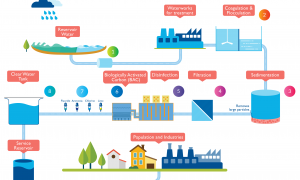🕑 Reading time: 1 minute
Contents:
What is Hydraulic Jump?
Hydraulic jump is the jump or standing wave formed when the depth of flow of water changes from supercritical to subcritical state. When the slope of open channel decreases from steep to mild, the depth of flow of water increases toward the critical depth and a flow instability occurs at some point. The flow becomes turbulent until the new normal depth is attained in the downstream. This is called a hydraulic jump.
Definition of different depths in Open Channel Flow:
It is required to understand what are different depths of flow, to understand the definition of hydraulic jump.Depth of flow:
Depth of flow is the depth at which water flows above the ground level in an open channel.Critical depth:
Critical depth of an open channel is the minimum depth of water above ground level at which the velocity of flow is very high and flow takes place with more of turbulence. The velocity of water at this depth is called as critical velocity.Supercritical depth:
Super critical depth is the depth of water which is smaller than critical depth and it represents very hard and super-critical situation for basic flows taking place in dams, weirs and many irrigation structures. The velocity of water at this depth is greater than the critical velocity. Flow in this region is called supercritical.Subcritical depth:
Subcritical depth is the depth greater than critical depth. The velocity of water at this depth is smaller than the critical velocity. Flow in this region is called subcritical flow.Basic Characteristics of Hydraulic Jump:
1. The jump is unsteady, irregular 2. Based on wind directions and heavy wind blow, it changes its property and can be choppy and undular sometimes.Uses of Hydraulic Jump:
The hydraulic jump is necessarily formed to reduce the energy of water while the discharge downfalls a spillway. It becomes necessary to reduce its energy and maintain stable velocities, that phenomenon is called energy dissipation in hydraulic structures.Types of Hydraulic Jumps – Based on Froude’s Number:
Basically a hydraulic jump occurs in many types depending on topographical features and bed surface roughness and many other natural interface relations. This hydraulic jump types can be probably expressed based on Froude’s number:1. Undular Hydraulic Jump – Froude Number (1 to 3):
Undular Jump is irregular, not properly formed and there are certain turbulences in water particles.
2. Weak Jump – Froude Number (3 to 6)
Weak jump takes place when the velocity in water is very less and the water particles cannot be stable and flows in various ways.
3. Oscillating Hydraulic Jump – Froude Number (6-20)
Oscillating jump forms when an oscillating jet enter into super critical state and there the number of particles starts oscillating in clockwise or either anticlockwise direction, forming slighter tides or waves to the top surface. Also the flow is dependent on heavy blow of air in one direction.
4. Steady Hydraulic Jump – Froude Number (20 to 80)
In steady jump, the bed surface is quite rough so the particles start to tend in one direction with heavy velocity and turbulence, frictional losses are more in this type of jump.
5. Strong Hydraulic Jump – Froude Number (greater than 80)
Strong jump is a perfect jump formed when frictional losses are more, air pressure division is equal and velocity is very high that losses take place. The water changes its state from super critical to subcritical in very shorter length when compared to all other types of hydraulic jumps, so this jump is highly preferred in dam structures. Read More:
What is a Weir? Types of Weirs and Flow Over Weirs
Hydrological Cycle – Process and Components
Types of Rain Gauges for Measuring Rainfall Data
Cross Drainage Works and its Types
Surge Tanks – Types of Surge Tanks, its Functions and Uses
Read More:
What is a Weir? Types of Weirs and Flow Over Weirs
Hydrological Cycle – Process and Components
Types of Rain Gauges for Measuring Rainfall Data
Cross Drainage Works and its Types
Surge Tanks – Types of Surge Tanks, its Functions and Uses 

